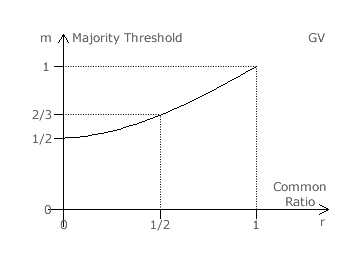Evaluations: Majority and Related Criteria 1
Majority Criterion
Suppose over half of all voters rank one particular candidate ahead of all the remaining ones. Given this majority first preference support, a voting system only satisfies the majority criterion when it ensures that this candidate always wins. Does CHPV or any other variant of GV meet this criterion?
Let there be two candidates say A and B and let m be the proportion of voters casting a first preference for the leading candidate A. Using GV, the best challenge that candidate B could mount against A would be to receive all the remaining first preferences (this smaller proportion = 1 - m) and the second preference of every voter that ranked A first (proportion = m). The proportion of first preferences (m) needed by A for victory in this worst case scenario varies according to the common ratio (r) used and is defined by the equation below.
The majority threshold is defined as the minimum value of m; namely when m = 1/(2 - r). When m is greater than this value, candidate A is guaranteed victory over B. However, when m is equal to this majority threshold value, a tie occurs between A and B. Therefore, the majority threshold is the value of m above which the leading candidate cannot be beaten under any circumstances.

As r rises from 0 towards 1, the majority threshold increases from 1/2 towards 1 as shown in the graph opposite. For GV to satisfy the majority criterion, m ≥ 1/2. The only value of the common ratio to satisfy this criterion is zero (r = 0). Like the plurality (first-past-the-post) voting system, this single GV variant does indeed satisfy the majority criterion.
Hence, GV (except where r = 0) and CHPV do not strictly satisfy the majority criterion.
However, if candidate A is confident of receiving a first preference from a simple majority of the voters, then A could instruct these supporters to truncate their ballots before ranking B so that B does not collect any second or lower preferences. This is called 'bullet' voting. If all A supporters complied with these instructions, then A would indeed be guaranteed to win with a simple majority (m ≥ 1/2) even when using GV; regardless of the common ratio actually employed.
Note that for elections using CHPV (GV with r = 1/2) a majority threshold of two thirds (m = 2/3) is required for victory regardless of the number of candidates competing in an election.
Proceed to next page > Evaluations: Majority Criteria 2
Return to previous page > Evaluations: General Criteria 4
